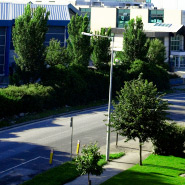Posted 13 January 2010
Scientists measure cleansing power of trees in city carbon emission tests
Instruments capable of measuring the ability of surrounding trees and vegetation to consume carbon dioxide emissions have been located at sites across Dublin. The idea is to understand how different types of urban landscapes cope with carbon dioxide (CO2) emissions, and how planners might create ‘carbon neutral’ or more sustainable city developments in the battle against carbon emissions.
The instruments which also measure wind, temperature, humidity and sunshine, record the CO2 concentration of the air as it passes by. They have been fixed on masts above Marrowbone Lane (an urban site with little or no surrounding trees or vegetation), and above St. Pius X Girl’s National School in Terenure (a suburban site with plenty of surrounding trees and vegetation).
A third instrument has been fixed to a mobile mast that can be located at different locations around the city. This will allow the scientists to measure the impact of heavy traffic and other key factors involved in the local carbon cycle.
The instruments will be in place for 3-5 years, as part of a joint research initiative led by scientists from University College Dublin and NUI Maynooth.
Globally, cities contribute about 80% of the CO2 emissions attributed to human activities, but the nature of these emissions is rarely studied. Through this research the scientists hope to better understand the urban processes that give rise to these emissions and to determine the ability of particular urban spaces to capture CO2 after its generation.
“While industry, traffic and other fossil fuel burning activities act as sources of CO2 emissions, trees, through the process of photosynthesis, remove carbon from the atmosphere,” says Dr Gerald Mills from the UCD School of Geography, Planning and Environmental Policy, University College Dublin. “In many urban areas, the absence of trees means that CO2 that might otherwise be captured in the city, drifts into the wider atmosphere and contributes to global climate change.”
“By measuring the flow of CO2 into and out of urban areas with different land use, our findings will help to inform city planners about the role of urban developments in moderating greenhouse gas emissions. This will contribute to broader discussions on carbon-neutral and sustainable cities,” he explains.
According to Dr Rowan Fealy from NUI Maynooth, until recently, these types of observations were not made in urban areas as they were regarded as far too complex.
“As a result, scientists have tended to estimate the CO2 emissions based how much fossil fuel is used. However, measuring the flux allows us to see the link between urban landscapes and their role in generating or consuming CO2,” he says.
“Located on masts at about twice the height of the surrounding buildings, the instruments record the net emissions arising from the cityscape below - emissions from traffic and industry minus the carbon captured by trees and other vegetation.”
Funding for the project was received from the Higher Education Authority (HEA).
Similar instruments to measure how urban land use affects CO2 emissions have been installed around several major cities worldwide including: New York and Tokyo.
(Produced by UCD University Relations)

